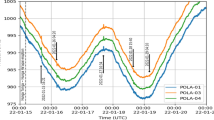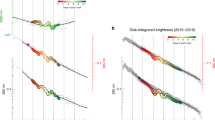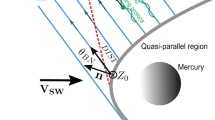Abstract
Using underground observations, we have found a small diurnal amplitude modulation of the cosmic-ray muon intensity which agrees in amplitude and phase with a first-order relativistic effect due to the Earth's motion, as discussed by Compton and Getting more than fifty years ago. The parent particles are sufficiently rigid (∼1.5TeV/c) that solar and geomagnetic effects should be minor. The muon flux deep underground is relatively insensitive to near-surface meteorological effects, and temperature effects at production height would produce intensity variations nearly out of phase with the observed effect. Analysis of the arrival times of 5 × 108 muons during a period of 5.4 yr yields a fractional amplitude variation of 2.5+0.7−0.6× 10−4, with a maximum near dawn, at 08:18 ± 1.0 h local mean solar time (LT). The expected amplitude is 3.40 × 10−4, with the maximum at 06:00 LT.
This is a preview of subscription content, access via your institution
Access options
Subscribe to this journal
Receive 51 print issues and online access
$199.00 per year
only $3.90 per issue
Buy this article
- Purchase on Springer Link
- Instant access to full article PDF
Prices may be subject to local taxes which are calculated during checkout
Similar content being viewed by others
References
Compton, A. H. & Getting, I. A. Phys. Rev. 47, 817–821 (1935).
Ryan, M. J., Ormes, J. F. & Balasubrahmanyan, V. K. Phys. Rev. Lett. 28, 985–988 (1972).
Cutler, D. J., Bergeson, H. E., Davis, J. F. & Groom, D. E. Astrophys. J. 1166–1178 (1981).
Gaisser, T. K. J. geophys. Res. 79, 2281–2286 (1974); Proc. 2nd int. Cosmic-Ray Symp. Jap. 33 (1976).
Groom, D. E., Loh, E. C., Nelson, H. N. & Ritson, D. M. Phys. Rev. Lett. 50, 573–576 (1983).
Davis, S. T., Elliot, H. & Thambyahpillai, T. Proc. 16th int. Cosmic-Ray Conf., Kyoto 4, 210–214 (1979).
Davis, S. T., Elliot, H., Marsden, R. G., Thambyahpillai, T. & Dutt, J. C. Planet. Space Sci. 27, 733–738 (1979).
Fenton, A. G. & Fenton, K. B. Proc. 14th int. Cosmic Ray Conf., Munich 4, 1482–1484 (1975).
Barrett, P. H., Bollinger, L. M., Cocconi, G., Eisenberg, Y. & Greisen, K. Rev. mod. Phys. 24, 133–178 (1952).
Chapman, S. & Lindzen, R. S. Space Sci. Rev. 10, 3 (1969).
Finger, F. G. & McInturff, R. M. J. atmos. Sci. 25, 1116 (1968).
Dorman, L. I. Cosmic Ray Variations (State Publishing House, Moscow, 1957).
Hashim, A., Speller, R. D. & Thambyahpillai, T. J. atmos. terr. Phys. 34, 1525–1535 (1972).
Lyons, P. R. A., Fenton, A. G. & Fenton, K. B. Proc. 17th int. Cosmic Ray Conf., Paris 4, 300–303 (1981).
Cutler, D. J. & Groom, D. E. Proc. 17th int. Cosmic Ray Conf., Paris 4, 290–293 (1981).
Bercovitch, M. Proc. 17th int. Cosmic Ray Conf., Paris 10, 246–249 (1981).
Gombosi, T., Kota, J., Somogyi, A. J. & Varga, A. Nature 255, 687–689 (1975).
Nagashima, K. et al. Proc. 14th int. Cosmic Ray Conf., Munich 4, 1503–1508 (1975).
Author information
Authors and Affiliations
Rights and permissions
About this article
Cite this article
Cutler, D., Groom, D. Observation of terrestrial orbital motion using the cosmic-ray Compton–Getting effect. Nature 322, 434–436 (1986). https://doi.org/10.1038/322434a0
Received:
Accepted:
Issue Date:
DOI: https://doi.org/10.1038/322434a0
Comments
By submitting a comment you agree to abide by our Terms and Community Guidelines. If you find something abusive or that does not comply with our terms or guidelines please flag it as inappropriate.



